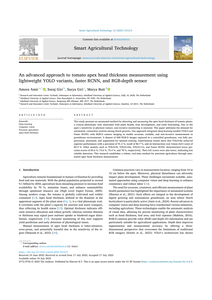Reducing the use of pesticides by early visual detection of diseases in precision agriculture is important. Because of the color similarity between potato-plant diseases, narrow band hyper-spectral imaging is required. Payload constraints on unmanned aerial vehicles require reduc- tion of spectral bands. Therefore, we present a methodology for per-patch classification combined with hyper-spectral band selection. In controlled experiments performed on a set of individual leaves, we measure the performance of five classifiers and three dimensionality-reduction methods with three patch sizes. With the best-performing classifier an error rate of 1.5% is achieved for distinguishing two important potato-plant diseases.
MULTIFILE

The objective of this book ‘An introduction to Smart Dairy Farming’ is to provide insight in the development of the Smart Dairy Farming (SDF) concept and advise as to how to apply this knowledge in the field of activities of students from universities of applied science. The information in this book includes background information and comprehensive insight in the concept of SDF.
DOCUMENT

This study explores how households interact with smart systems for energy usage, providing insights into the field's trends, themes and evolution through a bibliometric analysis of 547 relevant literature from 2015 to 2025. Our findings discover: (1) Research activity has grown over the past decade, with leading journals recognizing several productive authors. Increased collaboration and interdisciplinary work are expected to expand; (2) Key research hotspots, identified through keyword co-occurrence, with two (exploration and development) stages, highlighting the interplay between technological, economic, environmental, and behavioral factors within the field; (3) Future research should place greater emphasis on understanding how emerging technologies interact with human, with a deeper understanding of users. Beyond the individual perspective, social dimensions also demand investigation. Finally, research should also aim to support policy development. To conclude, this study contributes to a broader perspective of this topic and highlights directions for future research development.
MULTIFILE

Speech by dr. Robert Baars at the official inauguration as Professor in Climate Smart Dairy Value Chains at Van Hall Larenstein University of Applied Sciences, 24th September 2021, Dairy Campus, Leeuwarden, The Netherlands.
DOCUMENT

The Netherlands has always played a pioneering role in livestock and arable farming innovations. There is currently a lot of interest in our country for 'climate-smart' solutions, with closed-loop agriculture being an excellent example.
DOCUMENT

This booklet presents sixteen 'practice briefs' which are popular publications based on 12 Master and one Bachelor theses of Van Hall Larenstein University of Applied Sciences (VHL). All theses were commissioned through the research project entitled 'Inclusive and climate smart business models in Ethiopian and Kenyan dairy value chains (CSDEK)'. The objective of this research is to identify scalable, climate smart dairy business models in the context of the ongoing transformation from informal to formal dairy chains in Kenya and Ethiopia.
DOCUMENT

Powerpoint presentation used by Robert Baars at his inauguration on September 24, 2021 as lecturer 'Climate Smart Dairy Value Chains' at Van Hall Larenstein University of Applied Sciences.
DOCUMENT

This magazine presents the highlights of the applied research project “Inclusive and climate-smart business models in Ethiopian and Kenyan dairy valuechains (CSDEK)”. The CSDEK applied research project was conducted in six case study areas, three in Ethiopia and three in Kenya. At the time of publishing this magazine, research was still ongoing in some of the study areas. The projectteam and researchers hope to contribute to creating awareness of climatesmartdairy practices and development of the dairy sector in Ethiopia and Kenya. In two of the study areas, collaboration between VHL and dairy stakeholders will continue, preferably through local networks in a Living Lab approach.
DOCUMENT

This study presents an automated method for detecting and measuring the apex head thickness of tomato plants, a critical phenotypic trait associated with plant health, fruit development, and yield forecasting. Due to the apex's sensitivity to physical contact, non-invasive monitoring is essential. This paper addresses the demand for automated, contactless systems among Dutch growers. Our approach integrates deep learning models (YOLO and Faster RCNN) with RGB-D camera imaging to enable accurate, scalable, and non-invasive measurement in greenhouse environments. A dataset of 600 RGB-D images captured in a controlled greenhouse, was fully preprocessed, annotated, and augmented for optimal training. Experimental results show that YOLOv8n achieved superior performance with a precision of 91.2 %, recall of 86.7 %, and an Intersection over Union (IoU) score of 89.4 %. Other models, such as YOLOv9t, YOLOv10n, YOLOv11n, and Faster RCNN, demonstrated lower precision scores of 83.6 %, 74.6 %, 75.4 %, and 78 %, respectively. Their IoU scores were also lower, indicating less reliable detection. This research establishes a robust, real-time method for precision agriculture through automated apex head thickness measurement.
DOCUMENT

The Caribbean Netherlands are dealing with a situation where imported vegetables and fruits are mostly imported and hardly affordable. This leads to consuming unhealthy food and high obesities rates as a consequence. A lack of good agricultural practices with regard to water-smart and nature inclusive agriculture, as well as limited coping capacities to deal with hazards and climate change, results in very limited local production and interest. Initiatives that focused only on agrotechnological solutions for food resilient futures turned out to be ineffective due to a lack of local ownership, which jeopardizes sustainability. Moreover, the 'green' and 'blue' domains are not seen as attractive career perspectives among youth, hampering a bright future for those domains.
DOCUMENT
